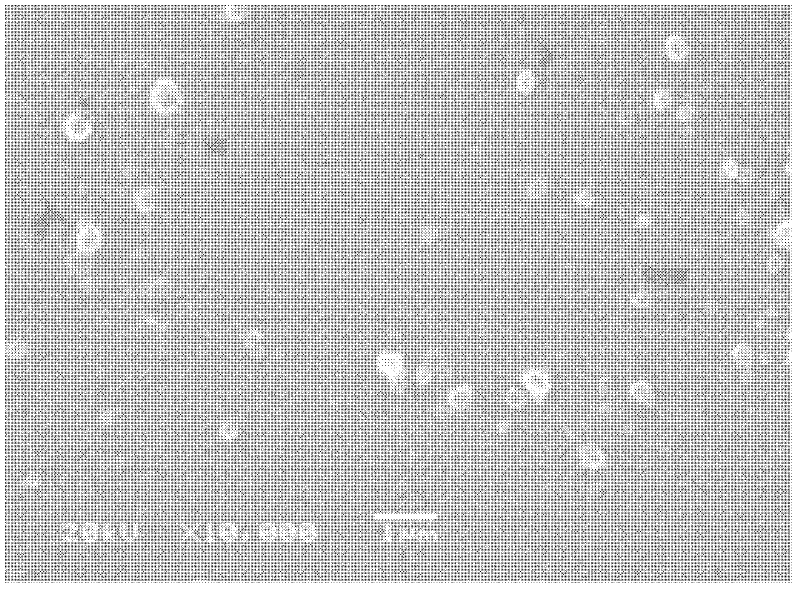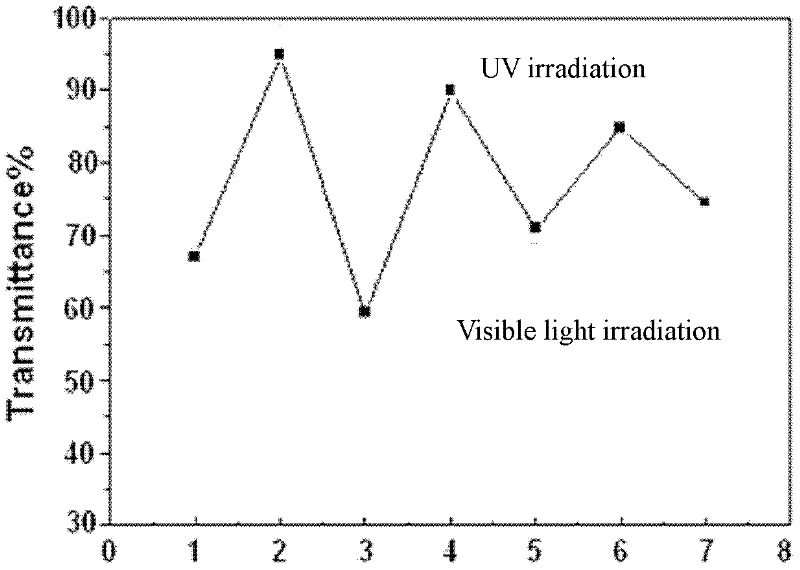Photoresponsive polymer microsphere system and preparation method thereof
A polymer, light-responsive technology, applied in the field of responsive polymer microsphere system materials, can solve the problems of difficult and precise control of the proportion and properties of the hydrophobic part of the polymer, irreversible response behavior, long-term and other problems, and achieves rapid controllable and The light transmittance changes significantly, the formation and disintegration are reversible, and the effect of broad application prospects
- Summary
- Abstract
- Description
- Claims
- Application Information
AI Technical Summary
Problems solved by technology
Method used
Image
Examples
Embodiment 1
[0024]Sodium alginate-tetradecyltrimethylammonium bromide complex was dissolved in MES solution (concentration: 5%), and stirred for 30 minutes to obtain polymer-formed microspheres. Then adjust the pH of the liquid to 14, add α-cyclodextrin (concentration is 5%), and then add monocarboxy azobenzene (concentration is 1.25%) to the system to obtain polyelectrolyte with UV-visible light response Microspheres. The structure and size of the polymer microspheres are shown in the attached figure 2 Scanning microscope photographs are shown.
[0025] Response to ultraviolet-visible light: when the obtained microsphere system was placed under a 500W ultraviolet lamp for 10 minutes, the light transmittance of the system increased from 65% to 95%, indicating that the microspheres in the system disintegrated. After being placed under a 500W incandescent lamp for 10 minutes again, the light transmittance of the system dropped from 95% to 55%, indicating that the microspheres were regene...
Embodiment 2
[0027] Polyacrylic acid grafted with dodecyl (grafting rate 15%) was dissolved in water to prepare an aqueous solution with a concentration of 1.5%, and stirred for 3 hours to form microspheres. Then add hydroxypropyl β-cyclodextrin (concentration: 1%) and stir to dissolve it. Then add dicarboxy azobenzene (concentration: 0.125%) into the system to obtain polyelectrolyte microspheres with ultraviolet-visible light response.
[0028] Response to ultraviolet-visible light: when the obtained microsphere system was placed under a 200W ultraviolet lamp for 1 hour and a minute, the light transmittance of the system increased from 50% to 90%, indicating that the microspheres in the system disintegrated. After being placed under a 200W incandescent lamp for 1 hour and a minute again, the light transmittance of the system dropped from 90% to 60%, indicating that the microspheres were regenerated. The process of disintegration and formation of microspheres can be repeated many times wi...
Embodiment 3
[0030] The tetradecyl-grafted polylysine was dissolved in an aqueous solution (the concentration of sodium alginate was 0.5%), and stirred for 3 hours to form microspheres. Then adjust the pH of the above liquid to 4, add α-cyclodextrin (concentration: 3%), and stir to dissolve it. Then add monohydroxy azobenzene (concentration is 0.75%) to the system to obtain polyelectrolyte microspheres with ultraviolet-visible light response.
[0031] Response to ultraviolet-visible light: when the obtained microsphere system was placed under a 600W ultraviolet lamp for 10 minutes, the light transmittance of the system increased from 40% to 79%, indicating that the microspheres in the system disintegrated. When placed under a 200W incandescent lamp again for 1 hour and a minute, the light transmittance of the system dropped from 79% to 47%, indicating that the microspheres were regenerated. The process of disintegration and formation of microspheres can be repeated many times with the cha...
PUM
| Property | Measurement | Unit |
|---|---|---|
| transmittivity | aaaaa | aaaaa |
| transmittivity | aaaaa | aaaaa |
| transmittivity | aaaaa | aaaaa |
Abstract
Description
Claims
Application Information
 Login to View More
Login to View More - R&D
- Intellectual Property
- Life Sciences
- Materials
- Tech Scout
- Unparalleled Data Quality
- Higher Quality Content
- 60% Fewer Hallucinations
Browse by: Latest US Patents, China's latest patents, Technical Efficacy Thesaurus, Application Domain, Technology Topic, Popular Technical Reports.
© 2025 PatSnap. All rights reserved.Legal|Privacy policy|Modern Slavery Act Transparency Statement|Sitemap|About US| Contact US: help@patsnap.com



